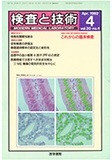Japanese
English
- 有料閲覧
- Abstract 文献概要
C反応性蛋白(CRP)は炎症状態や細菌感染時にその血中濃度が上昇する.血中ネオプテリン濃度は細菌性敗血症,ウイルス感染症や,移植片宿主拒絶反応のときに上昇する.血中CRP濃度およびネオプテリン濃度は骨髄移植患者21人(BMT),集中治療室(ICU)患者64人,そして頭頸部の扁平上皮細胞癌患者(HN)12名で毎日測定した.CRPと同時に血中ネオプテリン濃度をも測定することでBMT患者では感染症状態と移植片宿主拒絶反応とを区別することが可能であった.ICU患者ではCRP測定のみでは感染の特異的指標には不十分であり,また血中ネオプテリン濃度の測定を追加してもその特異度の向上の助けにはならなかった.この3つの患者群のいずれにおいてもネオプテリン/CRP比を求めても,臨床的には有用ではなかった.3つの患者群のいずれもそれぞれの基礎疾患に特徴的なCRPおよびネオプテリン濃度パターンを示した.BMT患者では移植片宿主拒絶反応による免疫学的活動を伴うため血中ネオプテリン濃度が優位に上昇した.感染症および炎症性疾患を伴うICU患者では血中CRP濃度とネオプテリン濃度の両方が上昇した.そして,局所的な炎症を伴うHN群では血中CRP濃度の上昇を示すが,ネオプテリン濃度には上昇がみられなかった.
C-reactive protein (CRP) concentrations are increased in plasma in people with inflammatory conditions and bacterial infections. Plasma neopterin concentrations are increased in people with bacterial septicemias, viral infections, and graft vs host disease. Plasma concentrations of CRP and neopterin were measured daily in 21 bone-marrow transplant (BMT) patients, 64 patients in intensive-care units (ICU), and 12 patients with squamous cell carcinoma of the head and neck (HN). In the BMT patients, plasma neopterin measurements in addition to CRP measurements allowed infectious episodes to be distinguished from graft vs host disease.In the ICUpatients, increased concentrations of CRP were not specific for infection andthe additional plasma neopterin measurements did not improve thisspecificity. In all three patients groups, the derivation of a neopterin/CRPratio was of no clinical use. These three groups of patients showed patternsof CRP and neopterin concentrations characteristic of their underlyingdiseases, the BMT patients with the immunological activation of graft vshost disease showed predominantly increased concentrations of plasmaneopterin, ICU patients with infectious and inflammatory conditions hadincreased concentrations of both CRP and neopterin in plasma, and the HNgroup with localized inflammation showed increased plasma concentrationsof CRP without increases in neopterin.
Copyright © 1992, Igaku-Shoin Ltd. All rights reserved.


